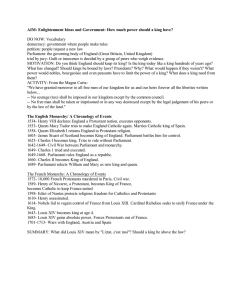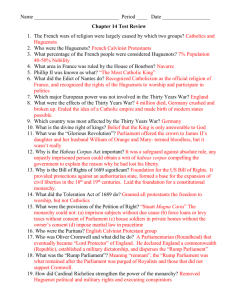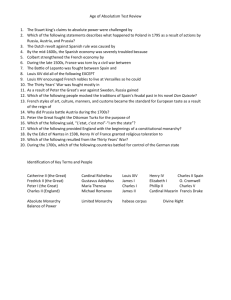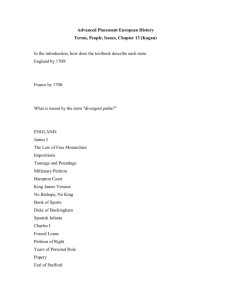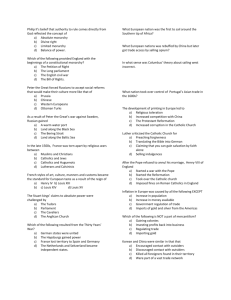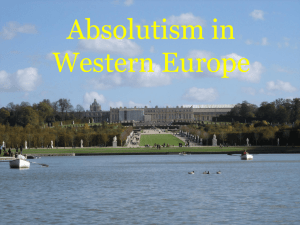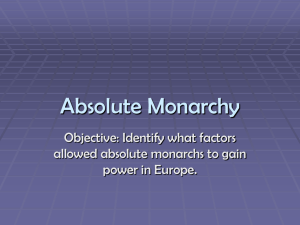Topic Five.AbsoluteConstitution.doc
advertisement
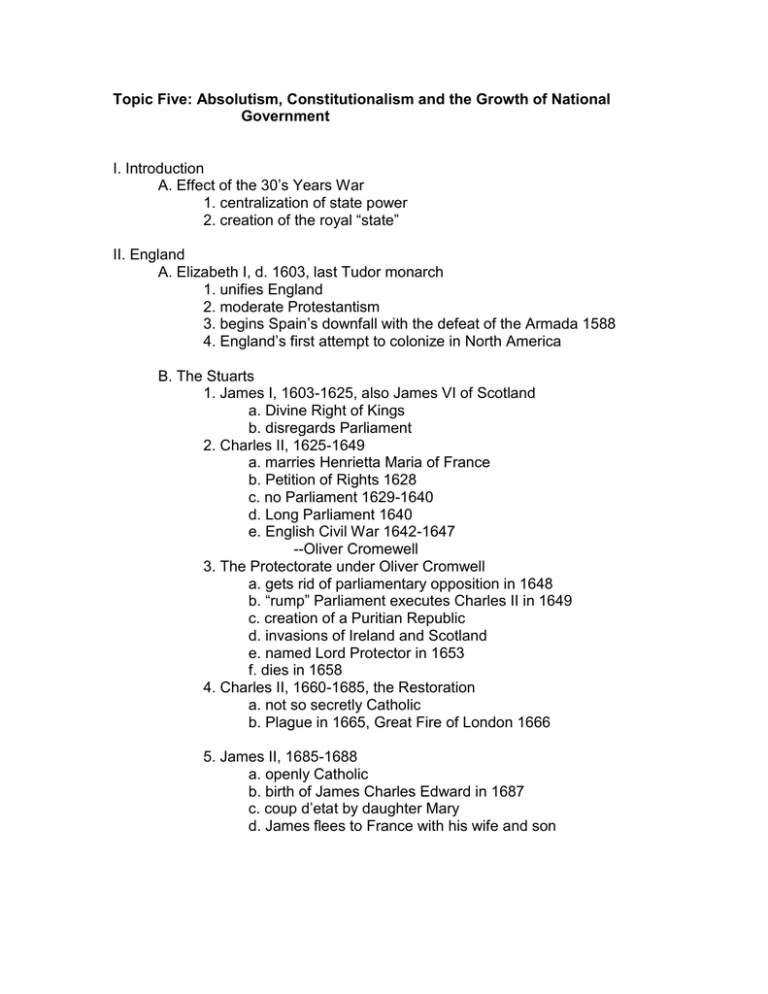
Topic Five: Absolutism, Constitutionalism and the Growth of National Government I. Introduction A. Effect of the 30’s Years War 1. centralization of state power 2. creation of the royal “state” II. England A. Elizabeth I, d. 1603, last Tudor monarch 1. unifies England 2. moderate Protestantism 3. begins Spain’s downfall with the defeat of the Armada 1588 4. England’s first attempt to colonize in North America B. The Stuarts 1. James I, 1603-1625, also James VI of Scotland a. Divine Right of Kings b. disregards Parliament 2. Charles II, 1625-1649 a. marries Henrietta Maria of France b. Petition of Rights 1628 c. no Parliament 1629-1640 d. Long Parliament 1640 e. English Civil War 1642-1647 --Oliver Cromewell 3. The Protectorate under Oliver Cromwell a. gets rid of parliamentary opposition in 1648 b. “rump” Parliament executes Charles II in 1649 c. creation of a Puritian Republic d. invasions of Ireland and Scotland e. named Lord Protector in 1653 f. dies in 1658 4. Charles II, 1660-1685, the Restoration a. not so secretly Catholic b. Plague in 1665, Great Fire of London 1666 5. James II, 1685-1688 a. openly Catholic b. birth of James Charles Edward in 1687 c. coup d’etat by daughter Mary d. James flees to France with his wife and son 6. William III and Mary II, 1688-1702 a. deposes father (and uncle) in the Glorious Revolution b. signed the Bill of Rights 1689 *cannot raise an army without Parliament’s consent *no taxes without approval of Parliament *Parliament must convene every three years *must have free elections *the monarchy must abide by the laws of England *the monarchy cannot veto Parliamentary laws C. Results 1. Constitutional monarchy is setup in England 2. inspires philosophers such as John Locke III. France A. Henry IV, 1589-1610, first of the Bourbon rulers of France 1. establish monopoly over essential imports and exports 2. restricts the power of the aristocracy 3. “nobility of the robe” 4. assassinated B. Louis XIII, 1610-1643 1. regency under Marie de Medici 2. Cardinal Richelieu, chief advisor 3. 30 Year’s War 4. propaganda and “raison d’etat” 5. hostility among the nobility C. Louis XIV, 1643-1715, the Sun King 1. regency under Anne of Austria 2. Cardinal Mazarin, chief advisor 3. Revolt of the Fronde, 1652 4. “l’etat, c’est moi” ! 5. Versailles 6. Bureaucracy created 7. Revoke Edict of Nantes in 1685 *”one king, one state, one religion” 8. War of the Spanish Succession 1702-1714 *wife is Marie Therese, daughter of Philip IV of Spain *Marie’s brother Charles II dies without an heir *Louis XIV claims throne for grandson, Philip of Anjou *coalition of European powers to stop Louis XIV *Peace of Utrecht 1713, Treaty of Rastast 1714 *Philip of Anjou becomes Philip V of Spain *Juan Carlos of Spain is descended from Philip V D. Result 1. Absolute monarchy in France 2. Nobility has no function in French politics 3. Middle Class is excluded from political power 4, France is the major European power under Louis XIV IV. Prussia A. Creation of Brandenburg-Prussia 1618 B. Frederick William I,1640-1688 1. military power 2. ties Prussia to this military system C. Frederick I, 1688-1713, first king of Prussia 1. absolutist state with militaristic overtones V. Austria-Hungary A. Leopold II, 1658-1705, Holy Roman Emperor 1. also Duke of Upper Silesia and Lower Silesia Count of Tyrol Archduke of Upper Austria and Lower Austria King of Bohemia King of Hungary and Croatia King of Styria and Moravia 2. empire consists of diverse ethnic, religious, cultural groups 3. used army to establish absolutist state 4. by 1699 kicks Turks out of Hungary 5. rebuilds Hungary in the Austrian-Baroque style VI. Russia A. Mongol rulers 12-36-1480 B. Ivan III, prince of Muscovy pushes out the Mongols in 1480 1. declares himself Czar (Caesar) 2. also declares his state the heir to Byzantium (Constantinople) 3. marries a surviving Byzantine princess 4. defender of the Orthodox Faith 5. Czar has absolute ownership of land and people 6. nobility turned into landowning elite in service to the czar C. Romanov dynasty comes to power in 1613 1. Alexei I, 1645-1676 a. Code of Laws 1649 stratifies Russian society b. heir is Feodor III 1676-1682 2. Ivan V 1682-1695 and Peter I (the Great) 1682-1725 a. regency under sister Sophia until 1789 b. Peter rules alone after 1695 c. tour of western Europe in 1697 d. westernizes Russia e. Great Northern War 1700-1718 3. Results a. absolultism in Russia b. no Middle Class or wage based labor system c. serfs gain no ground d. Russia is the dominant eastern European power

